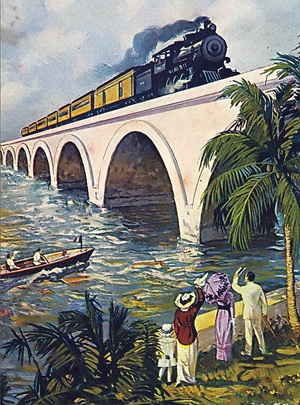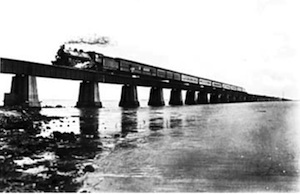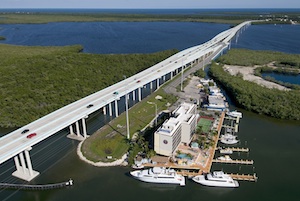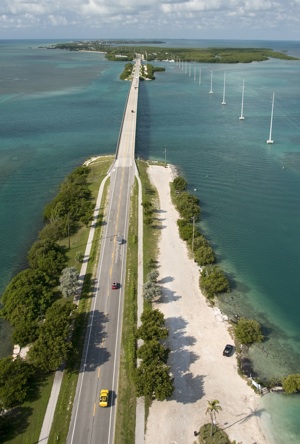'Highway That Goes to Sea' Derived From Century-Old Railroad
FLORIDA KEYS — The Overseas Highway, the southernmost leg of U.S. Highway 1, follows a trail originally blazed more than 100 years ago when Standard Oil millionaire Henry Flagler completed the Florida Keys Over-Sea Railroad.
In January 1912 the first Over-Sea Railroad train rolled from mainland Florida through the Keys to Key West, forever changing the face of many of the previously isolated islands by connecting them with the mainland and each other.
Construction on the rail line began seven years earlier, in 1905, motivated by an announcement that the Panama Canal would be built. Flagler thought Key West could become an important port and trade route with Cuba and Latin America, as well as a vital supply stop for ships entering or exiting the canal.
The railroad's track stretched more than 100 miles out over open water, requiring trailblazing construction techniques and nearly superhuman effort. Officially named the Florida East Coast Railway's Key West Extension, the line that became known as the Over-Sea Railroad was sometimes referred to as "the eighth wonder of the world." The bridges and viaducts connecting the Keys, including the landmark Seven Mile Bridge at Marathon, were regarded as an engineering marvel.
For more than two decades, the railroad carried passengers to the Keys and Key West, affording them a breathtaking sense of steaming across the open ocean. Its heyday abruptly ended when the line was severely damaged in a 1935 hurricane.
At that time the United States was in the grip of the Great Depression and the Florida East Coast Railway, already in receivership, was unable to afford repairs.
Less than three years later the Overseas Highway, a narrow thoroughfare for automobiles, replaced the tracks — marking the beginning of an incredible adventure for motorists. The highway's foundation incorporated some of the original railway spans, as well as the coral bedrock of individual keys and specially constructed columns.
The Atlantic Ocean lies on one side of the road, with Florida Bay and the Gulf of Mexico on the other, providing drivers breathtaking vistas of open water and sky.
Like the railroad, the highway represents an extraordinary engineering feat: 127 miles of roadway and 42 bridges leapfrogging across the water from key to key in a series of giant arches of concrete and steel. The well-known Seven Mile Bridge at Marathon stretches 6.79 miles across open water.
Just as Flagler's railroad was a marvel in its day, the Overseas Highway has been designated an All-American Road, the highest recognition possible under the National Scenic Byways program established by the U. S. Congress. The designation recognizes a roadway's archeological, cultural, historic, natural, recreational and scenic qualities, and its characteristics of national significance and features that make it a visitor destination in itself.
In 1982, 37 original bridges including the Seven Mile Bridge were replaced with wider spans. Approximately one-third of the original bridges were removed during the replacement project, while three of those remaining — Long Key, Bahia Honda and Seven Mile bridges — are on the National Register of Historic Places.
Many of the old bridges can still be seen alongside the newer ones, and some have become popular fishing piers. The Old Seven Mile Bridge, which parallels the contemporary one, is connected to the restored railroad camp on Pigeon Key. The bridge's center span was removed to facilitate boat traffic.
In September 2011, after nearly seven years of construction, a new $330 million road connecting the South Florida mainland with the Florida Keys was finished. The project's most iconic element, the 1.25-mile-long, 65-foot-high Jewfish Creek Bridge completed in May 2008, creates an impressive visual driving approach to the Florida Keys.
Today, drivers can leave Miami and travel the entire length of the Overseas Highway through all the Keys to Key West in less than four hours. Instead, however, travelers should allow time to experience the natural beauty of the ever-changing landscape and seascape bordering the roadway, and recall its beginnings as the remarkable Over-Sea Railroad.
Florida Keys visitor information: fla-keys.com or 1-800-FLA-KEYS
Social: Facebook • Twitter • YouTube

For more than two decades, the Florida Keys Over-Sea Railroad carried passengers to the Keys and Key West, affording them a breathtaking sense of steaming across the open ocean.

In January 1912 the first Over-Sea Railroad train rolled from mainland Florida through the Keys to Key West, forever changing the face of many of the previously isolated islands by connecting them with the mainland and each other.

The 1.25-mile-long, 65-foot-high Jewfish Creek Bridge creates an impressive visual driving approach to the Florida Keys. Photo: Andy Newman/Florida Keys News Bureau

Along the Overseas Highway, the Atlantic Ocean lies on one side of the road, with Florida Bay and the Gulf of Mexico on the other, providing drivers breathtaking vistas of open water and sky. Photo: Andy Newman/Florida Keys News Bureau

